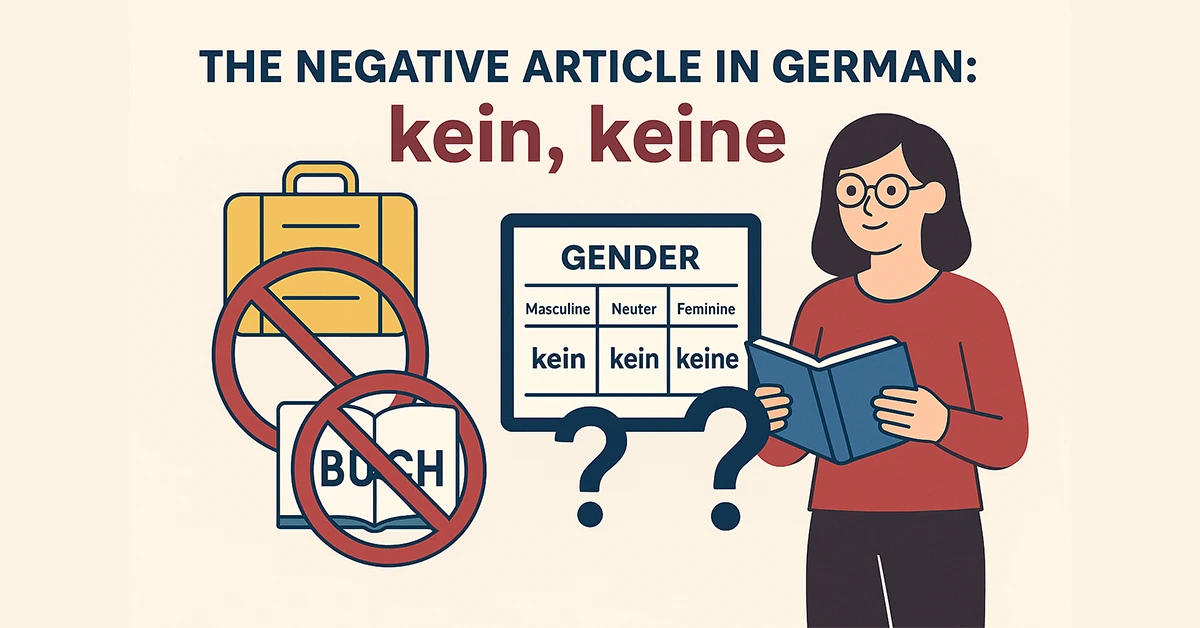The Negative Article in German: kein, keine Explained

Understand how to use kein, keine, keinen as negative articles in German. Learn with examples and how they differ from nicht.
What Is the Negative Article in German?
In German, negative articles like kein and keine are used to negate the existence of something. They are the negative counterparts of the indefinite articles ein and eine.
When to Use “kein,” “keine,” and “kein”
Use kein when you want to say “no” or “not any” in front of a noun. The form changes depending on the gender and case of the noun.
Gender and the Negative Article
- kein – masculine/neuter (Nominative)
- keine – feminine (Nominative), all genders (Plural)
- keinen – masculine (Accusative)
Negative Articles by Case
| Case | Masculine | Feminine | Neuter | Plural |
|---|---|---|---|---|
| Nominative | kein | keine | kein | keine |
| Accusative | keinen | keine | kein | keine |
| Dative | keinem | keiner | keinem | keinen |
| Genitive | keines | keiner | keines | keiner |
How “kein” Changes in the Nominative, Accusative, Dative, and Genitive Cases
“Kein” acts like an adjective and declines accordingly based on case and gender. Memorizing the chart above helps understand the pattern.
Negative Articles with Plural Nouns
All plural nouns use keine in Nominative and Accusative cases, regardless of gender. Example: Ich habe keine Bücher.
kein vs. nicht – What’s the Difference?
Use kein before nouns without an article. Use nicht to negate verbs, adjectives, or definite nouns. Example: Ich habe kein Auto. vs. Das ist nicht mein Auto.
Examples of kein in Real German Sentences
- Ich habe kein Geld.
- Er isst keinen Käse.
- Wir haben keine Zeit.
Using “kein” with Different Verb Types
“Kein” is commonly used with verbs like haben (to have), sehen (to see), and brauchen (to need). Always check whether the object is countable and indefinite.
Using “kein” in Questions and Answers
“Kein” appears in both questions and their negative answers. Example: Hast du ein Auto? – Nein, ich habe kein Auto.
Negating Professions and Nationalities with kein
Use kein when negating without an article: Er ist kein Lehrer. This works because professions are usually stated without articles in German.
How Word Order Affects the Use of “kein”
Word order doesn’t change the form of kein, but the position affects clarity. Keep kein close to the noun it’s negating.
Common Mistakes with the Negative Article
- Using nicht instead of kein
- Wrong declension of kein
- Forgetting plural always uses keine
Tips to Avoid Overusing “kein”
Don’t replace nicht with kein everywhere. Only use kein for indefinite nouns, not verbs or adjectives.
Quick Grammar Tips to Remember kein
Think of kein as “not a” or “no” in front of a noun. If you could use “ein,” then you can also use “kein.”
Advanced Examples of kein in Context
Example with Genitive: Wegen keines Beweises wurde er freigesprochen. – “Because of no evidence, he was acquitted.”
Practice Exercises: How Well Do You Know kein?
- Ich habe ____ Auto. (kein)
- Sie isst ____ Brot. (kein)
- Er hat ____ Freunde. (keine)
FAQs About the Negative Article “kein” in German
Can I use “kein” with definite nouns?
No, “kein” is only for indefinite nouns. For definite nouns, use “nicht.”
Is “kein” used in the same way in spoken and written German?
Yes, although in spoken German, contractions and dropped words are more common.
Conclusion: Mastering the Negative Article in German
Learning how to use kein correctly will boost your confidence and help you sound more natural in German. Practice regularly and review declension tables often.